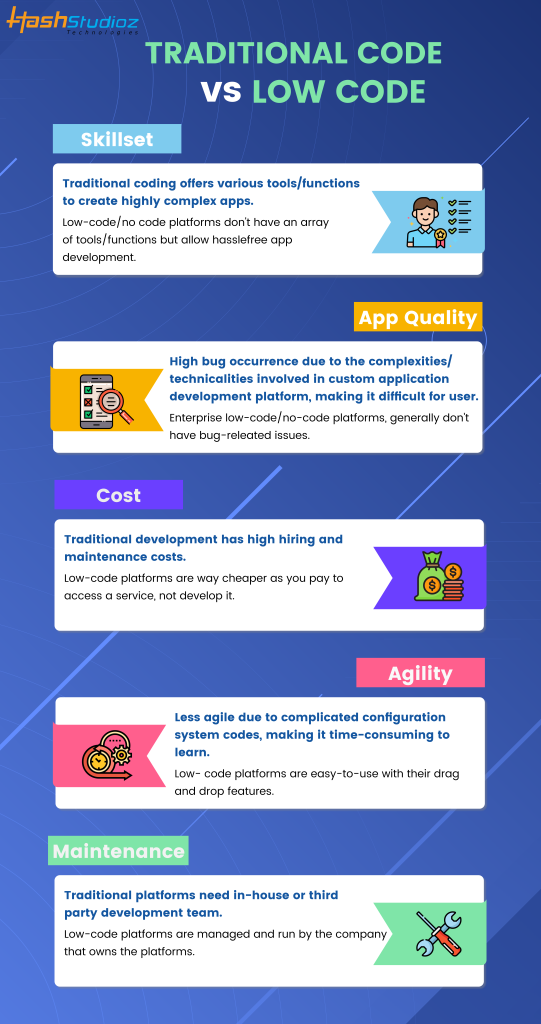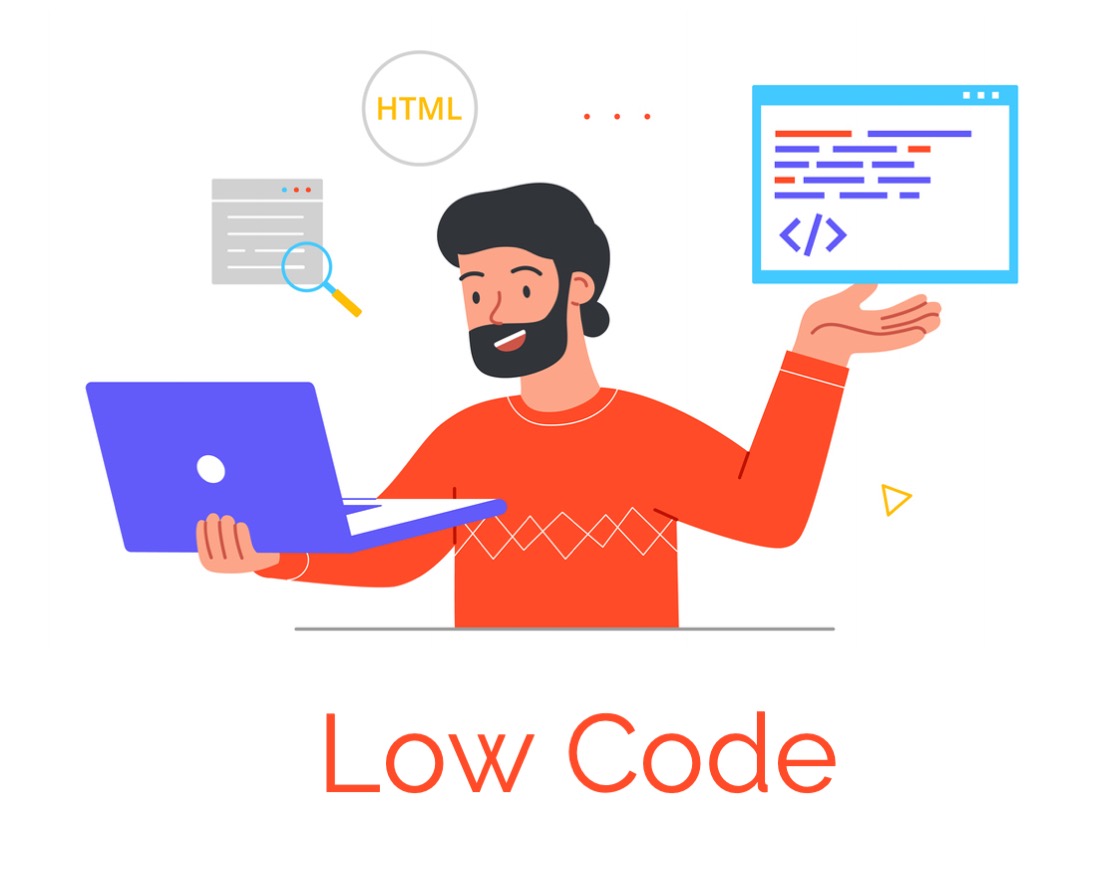Handy News To Picking Low-Code Platform Examples
Handy News To Picking Low-Code Platform Examples
Blog Article
Benefits Of Low-Code Application Development In Terms Of Accessibility To Non-Developers
Due to a number of key factors, Low-code Application Development is available to non developers. These are referred to as "citizen designers."
Drag-and-Drop Builders: Low-code platforms have drag-and drop interfaces that allow non-developers to create apps without having to write a single line of code. This makes it simpler for people who don't have technical background to participate in the development process.
WYSIWYG Editors - "What You See Is What You Receive" editors assist users in creating workflows and interfaces that appear similar to the final product which makes them more understandable.
Simple workflow and logic
Visual Workflow Modeling: Users are able to create business processes and application logic by using visual flowcharts or models, which are more user-friendly than the traditional methods of coding.
Pre-built Components of Logic Low-code platform often includes already-built logic (e.g. loops or conditional statements) that are easily adjusted, thus reducing the need for complex programming.
Reusable Components and Templates
Library of pre-built templates Numerous low-code platforms have a library of templates for common application types which allow non-developers to start with a solid foundation to alter as required.
Reusable Widgets and Modules Users can make use of reused widgets and modules which can be created faster, reducing the time needed to create them and reducing the requirement for technical expertise.
Guided Development & Tutorials
Step-byStep Guides: Platforms will frequently provide guided development pathways or online tutorials on-screen instructions to assist users who aren't developers to create applications.
Interactive Tutorials Interactive tutorials that allow you to interact with the platform will help you learn and gain confidence.
Integration with existing tools:
Integration seamless Low-code platforms are developed to integrate seamlessly with existing business systems and tools (e.g. ERP, CRM) making it possible for non-developers to develop applications that fit into their workflows.
APIs and Connectors: APIs built-in and connectors make it easier to integrate the process and allow non-developers to connect their applications to external services without the need for the need for complicated programming.
Collaboration Features:
Team Collaboration: Real-time collaboration, shared workspaces, and shared workspaces enable business analysts, non-developers, and other stakeholders to effectively collaborate with developers who are professionals.
Access Control Based on Roles: Users who do not develop can have access to roles and levels of access that permit them to contribute without compromising security or functionality.
Automated Tests and Debugging
Test Tools Included: A lot of low-code platforms have integrated debugging and testing tools. These tools streamline the procedure, making it simple for non-developers to ensure their applications are working correctly.
Error Highlighting Whenever errors are detected the platform highlights these and suggests solutions. It helps non-developers in troubleshooting.
Overall, the advantage of developing applications using low-code for accessibility for non-developers is in its ability to make development more accessible. By providing intuitive, visual tools and guided experiences low-code platforms enable business users to participate actively in developing and maintaining apps, thus bridging the gap between business needs and the technical implementation. Take a look at the most popular Low-code Platform for application development info for site info including application modernisation, cloud software applications, push notifications, rapid app development, push notifications android, application modernization, sso azure, app development platform, developing mobile apps, cross platform app dev and more.
Benefits Of Low-Code Application Development In Security And Governance
Low-code application design offers many advantages when it comes to security and governance. Both are essential for making sure that apps remain compliant, secure and well-managed throughout their lifecycle. Here are a few of the major advantages:
Unified Manage Console: Lowcode-based platforms generally provide a management console allowing administrators to supervise and manage applications.
Role-Based Access Control (RBAC): These platforms typically include an extensive role-based access control system, allowing administrators to define and enforce access policy. Only authorized users are able to access and modify certain parts of the application.
Compliance and Regulatory Adherence:
Many low-code platforms include built-in compliance functions. For example, they are developed in accordance with the industry standards, regulations and laws (e.g. HIPAA, GDPR). These platforms provide frameworks and tools to ensure that applications are in compliance with these regulations.
Audit Trails & Logging: Complete audit trails and logs can be integrated to allow companies to monitor changes, monitor access and ensure conformity.
Enhance Security Measures
Data encryption. Low-code platforms offer encryption for data both at rest and when it is transmitted, which ensures sensitive information remains protected.
Security Certifications: A lot of low-code companies have security certifications (e.g., ISO 27001, SOC 2) that show that they adhere to the highest security standards. This provides an additional level of security to customers.
Automated updates for security:
Regular Security Updates and Patches Low-code platforms handle automatic security updates, patches and upgrades. The applications are thus protected from the latest threats without the need for developer intervention manually.
Security Monitoring: Constant security monitoring tools are included to provide real-time notifications and information on security concerns.
Data Governance
Data Access Policies These systems allow organisations to create data access rules and enforce the policies, making sure that data is available only to those who have been granted access. They also make sure that the data is being used in a safe manner.
Data Masking and Anonymization Built in tools to mask data and ensure the security of sensitive information, especially in development environments and testing environments.
Consistent application lifecycle management:
Pipelines for Deployment and Development Low-code platforms typically offer integrated development and deployment pipelines which include security checks to ensure that security remains intact throughout the application lifecycle.
Version Control. Integrated version management helps identify and reverse any modifications that are made to the program, making sure that the integrity of it is preserved.
User authentication:
Single Sign-On (SSO). Support for advanced authentication and single sign-on makes it easier and increases security.
Multi-Factor Authentication - Many platforms support multi-factor Authentication, which adds an extra layer to security when accessing applications.
Policy Enforcement and Compliance Monitoring:
Low-code platforms include policy templates predefined that can help organizations implement governance policies and security policies.
Tools for Compliance Monitoring: These tools monitor and report continuously on compliance status. They allow you to find issues and deal with these issues in a proactive fashion.
Integration into Existing Security Infrastructure
Seamless Intergration: Low code platforms are designed to allow seamless integration with security tools and equipment, such as Identity Management Systems SIEM Solutions (Security Information and Event Management), and Firewalls.
API Security API Security features allow integration with other systems, protecting data and maintaining integrity of applications.
Training and best practices:
Best practices: Many platforms provide guidelines for creating secure applications and provide the best practices. This can help non-developers comply with security standards.
Security Training Some low-code service providers provide security tools and training for users to educate them on how to create and maintain secure applications.
All in all, low-code app developers provide a security and governance benefit that enables them to develop and manage applications in a safe, secure and secure way. These platforms include the frameworks and tools needed to supervise and control development of applications, as well as protect sensitive data while maintaining regulatory compliance and enforcing policies. Take a look at the top a replacement on Enterprise application development with Low-code Platform for site examples including paas service, rad development, push notifications, sso azure, develop cross platform mobile app, rapid app development, database in azure, app development platform, application modernization, cross platform mobile development and more.
Vendor Support And Community Are Two Of The Advantages Of Low Code Application Development.
Low-code development platforms for applications can be an excellent method to gain vendor support as well as community participation. Both are vital for ensuring the success of your implementation as well as ongoing maintenance of the app. Support from the Vendor
Comprehensive Technical Support:
Support Teams: Most platforms that make use of low-code offer designated support teams that can help with technical issues, troubleshooting and guidance.
24/7 Support Some suppliers are available all hours of the day, which is beneficial to businesses operating in multiple time zones.
Training and Onboarding
Vendors provide structured training courses such as webinars, tutorials, and certificates to help users become familiarized with the platform.
Customized Onboarding A lot of vendors offer personalized services to help their new clients implement the platform effectively and customize it to their needs.
Regular updates and enhancements
Continuous improvement: Low-code platform providers generally release periodic updates that include the latest features, performance enhancements as well as security patches, making sure that their platform is up-to-date and safe.
Feedback Integration: Many vendors integrate user feedback in their process of development. This ensures that the platform can adapt to the changing demands and needs of its customers.
Comprehensive Documentation:
Documentation is detailed: Users are usually able to access a large and well-organized documents, ranging in complexity from basic customization to advanced usage.
API References In-depth API documentation enables developers to create custom applications and integrate low-code platforms with other systems.
Professional Services and Consulting
Expert Consulting: Most vendors offer consulting services to help with architectural planning, strategic planning and complex implementations. This assists users to maximize the software's capabilities.
Custom Development: Certain vendors offer services that allow them to create specific features or systems that aren't offered from the beginning.
Community Support for the Community
Active User Community:
Forums and discussion boards Forums and discussion boards: A lot of low code platforms have vibrant online communities that let users inquire about issues, exchange ideas and work together on best practices.
Local and virtual user groups, as well as Meetups, provide opportunities for users to exchange experiences, learn from others, and build relationships.
Collaboration and knowledge sharing:
Community-Contributed Resources: Users often share templates, modules, and extensions that they have developed, which can be reused or adapted by others, accelerating development and innovation.
Crowdsourced Problem Solving: The collective wisdom and experience of the crowd can be an invaluable resource for troubleshooting issues and finding innovative solutions to difficult issues.
Learning and Development
Community-led Training: Many groups organize workshops, training sessions and webinars. They are usually led by experienced users, who share practical knowledge and advanced techniques.
Online Courses and Tutorials Community members regularly make and share online tutorials, courses, and how-to guides, enhancing the educational resources available to all users.
Feedback and Influence
Forums for Product Feedback Community forums contain a number of channels for giving feedback to vendors, which can help shape the development of new features.
Beta Testing members of active communities could be able to be part of the beta testing process. This lets them gain early access and to be part of the creation of the platform.
Recognition and Encouragement
Community Recognition Programs - Many vendors have recognition programs that acknowledge the efforts of the active members of their community and include MVP (Most Valuable Professionals) programs.
Peer Support: Members of the community often provide peer support by sharing their knowledge and providing guidance to users who are not as familiar creating a more collaborative and supportive environment.
The overall result of solid vendor with active and engaged communities. They provide a complete environment for the support of low-code applications development. Users will have the knowledge and resources to develop, deploy and maintain their application.